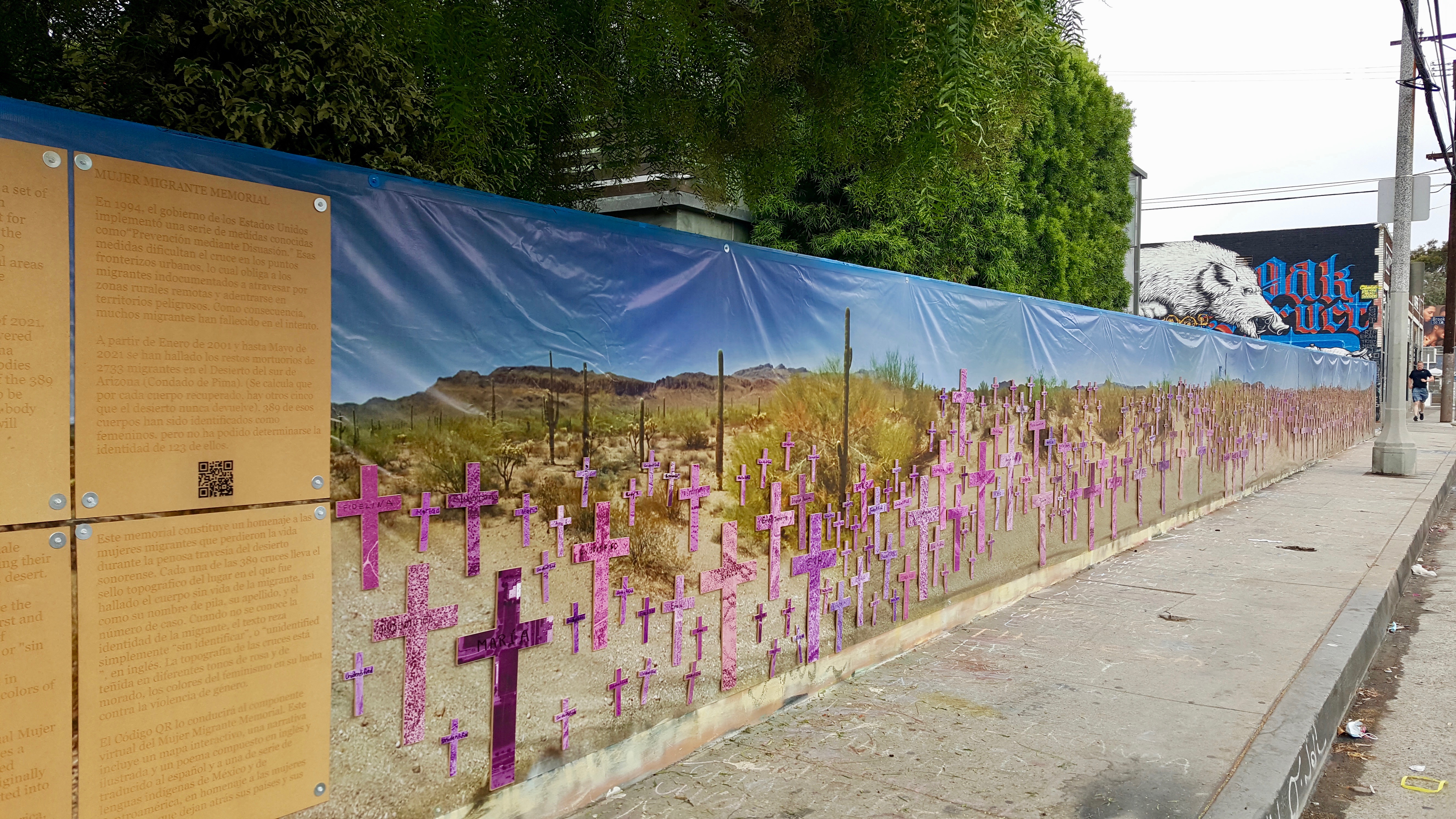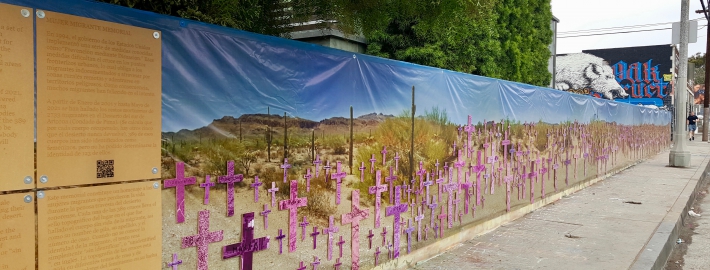Mural pays respect to remains of women found near the U.S.-Mexico border
UCLA’s Maite Zubiaurre led the creation of art installation, virtual map honoring those who died
By Madeline Adamo

To try to balance against the stark brutality of the numbers, the crosses are shrouded in a color filter of soft pink and purple to represent the fight of international feminism against gender violence. Photo Credit: Filomena Cruz
As you walk along Pacific Avenue in Venice there’s a tattoo parlor — its side wall covered in graffiti — scraps of trash strewn about. Across the alley, interrupting the classic beach community scene, you encounter a wall installation of 389 pink and purple wooden crosses affixed to a 90-foot panoramic backdrop of cacti, sand and desert brush.
Names adorn the crosses: “Paulina,” “Rosa,” “Maria,” “Fabiola,” are among them, but so many are “unidentified.”
Each cross represents a female migrant who died in Pima County, Arizona, near the U.S.–Mexico border from January 2001 through May 2021.
The exhibit is one part of a project called Mujer Migrante Memorial, a touring urban art installation and accompanying website created to memorialize female migrants and mourn their deaths in the southern Arizona border region, while raising awareness about migrant death in the U.S.–Mexico borderlands. The website includes poetry, background information and statistics and photos. There’s also a map that indicates the exact locations where remains were recovered; on the installation the individual crosses are coated with photography of these locations individualized to where each set of remains were found.
“It’s so horrifying that there are so many bodies found in the desert and that the wall is covered with so many crosses,” said Maite Zubiaurre, a UCLA professor of European languages and transcultural studies and an artist who signs as Filomena Cruz, who led the creation of the project.
Women make up 15% of the close to 3,800 migrant remains recovered from the southern Arizona desert since the 2000s. To try to balance against the stark brutality of the numbers, the crosses are shrouded in a color filter of soft pink and purple to represent the fight of international feminism against gender violence.
“The whole thought process was ‘how can we honor the migrants without actually re-traumatizing family if they see it,’” said Zubiaurre, also a professor of Spanish and Portuguese, who noted that some of the crosses show a road or even a highway because that’s where the remains were found.
“This means that the migrant who died there probably died listening to the cars rolling by and could have been saved,” she said.

Aguilas del Desierto/Desert Eagles volunteers using chalk to write the names of the female migrants who died in the Arizona desert, as part of the Mujer Migrante Memorial installation. Photo Credit: Filomena Cruz
The Mujer Migrante Memorial (which translates as migrant woman memorial) project sprang from a UCLA graduate urban humanities seminar about border culture that Zubiaurre taught.
Intrigued by a concept called “migrant trash,” the xenophobic term used to designate the personal belongings migrants leave behind in the Arizona desert, and inspired by UCLA anthropologist Jason de León’s groundbreaking research on migrant death, Zubiaurre began working with the Pima County Office of the Medical Examiner in Tucson, Arizona, to learn more about how they archive things migrants leave behind and the role those belongings’ play in identifying remains.
“The degree of compassion and empathy and effort of the forensic personnel at Pima County to identify the victims is absolutely stunning. My co-author, Jonathan Crisman, who is an assistant professor at the University of Arizona, came up with the term ‘forensic empathy,’” Zubiaurre said. She explained “forensic empathy” as a collaborative, interdisciplinary project on migration and migrant death, which Zubiaurre leads, that includes documentaries, art installations and scholarly research.
“As a group of ‘mujeres’ from various backgrounds, we merged as a collective,” said Eliza Franklin-Edmondson, a graduate student of Zubiaurre’s, who looks forward to the project’s continuation. “This critical issue of mujer migrante death at the border is being overlooked nationally.”
Zubiaurre said that the reception to the installation has spanned from one incident of vandalism (crosses reading “unidentified” were ripped from the wall and littered on the sidewalk) to viewers coming to tears because of their own migration stories. The memorial wall’s location isn’t lost on viewers either.
“We transported the Sonoran Desert into Los Angeles, but the truth is that that desert is in Los Angeles already because it is part of the cultural imaginary of our migrant community,” said Zubiaurre, who added that she was unfazed by the vandalism.
“That’s the spirit of the wall, it’s an urban installation,” she said, “good and bad will happen to that wall over time.”
The memorial’s installation in June brought scholars (mostly from UCLA), artists, members of the community and activist groups (among them the search and rescue group Aguilas del Desierto and the Colibri Center for Human Rights) to the wall.
Under the guidance of Tucson-based, Colombian artist Alvaro Enciso, the names of all 389 victims were written in chalk on the sidewalk and down a quiet path leading to the ocean, said Zubiaurre, who also played a recording of herself reading all of the victims’ names as participants affixed the crosses to the panoramic backdrop. For those whose names are unknown “unidentified” or “sin identificar” was written in chalk and spoken as part of Zubiaurre’s recording.
Franklin-Edmondson read her original poem in conjunction with the project through a megaphone. Police helicopters circled, wary of disturbance, which Zubiaurre said did not surprise her. The website includes the translation and recitation, by women translators and reciters, of the poem in Spanish and in some of the indigenous languages spoken by migrants, such as Nahuatl, Mixtec, Purepecha, Tzotzil and Zapotec.
“I saw this poem as a sacrifice to this sacred journey taken by so many … an auditory legacy of those that lived, died, and to those who survived and crossed the border,” said Franklin-Edmondson.
The project’s next installation will be in Tucson in August. Under the guidance of Enciso, an abandoned building will be adorned with red dots to represent the close to 3,800 bodies found in the southern Arizona borderlands since 2000. That number of deceased migrants recovered from the Southern Arizona desert in 2021 is already 81.
Future iterations of the project are also planned in Mexico City and Mexico’s southern border with Guatemala.
In addition to Zubiaurre and Franklin-Edmondson, the other creators include Maha Benhachmi; Miranda Hirujo-Rincón; Xiuwen Qi; Cristina Vázquez; Dignicraft, an art collective, media production company and distributor of cultural goods, and its creators, José Luis Figueroa, Omar Foglio and Paola Rodríguez.
This article originally appeared in the UCLA Newsroom.


 Filomena Cruz
Filomena Cruz Courtesy of Margaret Kivelson
Courtesy of Margaret Kivelson